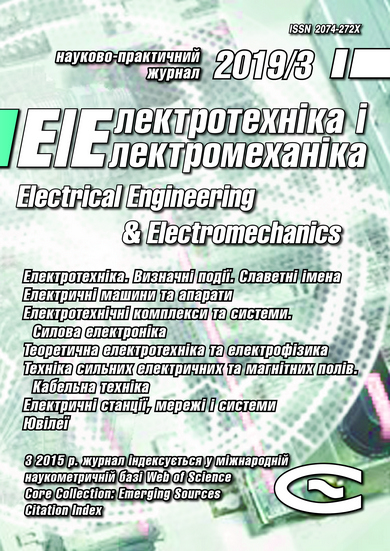THE MICRO- AND NANOSECOND DISCHARGES IN GAS BUBBLES FOR WATER DISINFECTION AND PURIFICATION
DOI:
https://doi.org/10.20998/2074-272X.2019.3.08Keywords:
high-voltage generator, micro- and nanosecond pulses, discharge in gas bubbles in water, disinfection and water purification by discharges, inactivation of microorganismsAbstract
Purpose. Comparison of electrical circuits of experimental plants for obtaining micro- and nanosecond discharges in gas bubbles in water and comparing the experimental results obtained for disinfecting water using such discharges. Methodology. To obtain high-voltage pulses on the load in the form of a gas bubbles and a layer of water with a frequency of more than 2000 pulses per second, a method of generating micro- and nanosecond pulses using high-voltage pulse generators based on a pulse transformer (PT) according to Tesla, with a transistor opening switch IGBT in the low-voltage part of the circui . A current-limiting resistor with a resistance Rcl = 24 kW is used to protect the transistor switch at microsecond discharges. At nanosecond discharges, a multi-gap spark gap is used to sharpen the front of high-voltage pulses. We used a capacitive voltage divider with a division factor of Kd = 7653 to measure voltage pulses, a shunt with a resistance of Rs = 2.5 W for measuring current pulses. RIGOL DS1102E digital oscilloscope with a 100 MHz bandwidth was used as a recording device. Results. The effect of micro- and nanosecond discharges in gas bubbles on microorganisms was experimentally investigated. It was possible to reduce the biochemical oxygen consumption of water during microsecond discharges, reduce the turbidity of water, and improve its organoleptic qualities. The energy released in a single pulse with microsecond discharges Wµ ≈ 17 mJ, with nanosecond discharges Wn ≈ 7.95 mJ. At nanosecond discharges, complete inactivation of E.coli bacteria was achieved. The disinfecting and purifying action of nanosecond pulses is better compared to microsecond pulses due to an increase in the amplitude of the pulsed voltage up to 30 kV, and a pulsed current of up to 35 A. Originality. The possibility of effective microbiological disinfection of water using nanosecond discharges in gas bubbles at low specific energy consumption has been experimentally shown. Practical value. The obtained experimental results on water disinfection using micro- and nanosecond discharges offer the prospect of industrial application of installations using such discharges for disinfecting and purification wastewater, swimming pools, and post-treatment of tap water.References
Gershman S., Mozgina O., Belkind A., Becker K., Kunhardt E. Pulsed Electrical Discharge in Bubbled Water. Contributions to Plasma Physics, 2007, vol.47, no. 1-2, pp. 19-25. doi: 10.1002/ctpp.200710004.
Boyko N.I., Makogon A.V. Experimental plant for water purification with the help of discharges in gas bubbles. Technical Electrodynamics, 2017, no.5, pp. 89-95. doi: 10.15407/techned2017.05.089.
Boyko N.I., Makogon A.V. Generator of high-voltage nanosecond pulses with repetition rate more than 2000 pulses per second for water purification by the discharges in gas bubbles. Technical Electrodynamics, 2018, no.4, pp. 37-40. doi: 10.15407/techned2018.04.037.
Boyko M.I., Makogon A.V., Marynin A.I. Energy efficiency of the disinfection treatment of liquid foodstuffs by high-voltage pulse effects. Electrical engineering & electromechanics, 2018, no.3, pp. 53-60. doi: 10.20998/2074-272X.2018.3.07.
Trofimova S.V., Ivanova I.P., Bugrova M.L. The analysis of structural changes of prokaryotic and eukaryotic cell under the influence of plasma spark radiation. Fundamental research, 2013, no.4(part 1), pp. 130-133. (Rus).
Ivanova I.P., Trofimova S.V., Piskaryov I.M., Burkhina О.Е., Sysoeva V.А., Karpel Vel Leitner N. The Study of Biocidal Mechanisms of Spark Discharge Plasma Radiation. Modern Technologies in Medicine, 2012, no.3, pp. 12-18. (Rus).
Available at: http://www.chem.msu.su/rus/handbook/redox/elem_dat/o.html (accessed 13 June 2018). (Rus).
Nazarenko O.B, Shubin E.G. Investigation of Electric Discharge Treatment of Water for Ammonium Nitrogen Removal. Proceedings of the 2nd Environmental Physics Conference, 18-22 Feb. 2006, Alexandria, Egypt, pp. 85-90.
Iavorovskii N.A., Kornev Ya.I., Preis S.V., Pel'tsman S.S., Khaskel'berg M.B., Chen B.N. Pulsed barrier discharge as a method of water treatment: active particles-oxidizing agents in the water-air flow. Bulletin of the Tomsk Polytechnic University, 2006, vol.309, no.2, pp. 108-113. (Rus).
Downloads
Published
How to Cite
Issue
Section
License
Copyright (c) 2019 N. I. Boyko, A. V. Makogon

This work is licensed under a Creative Commons Attribution-NonCommercial 4.0 International License.
Authors who publish with this journal agree to the following terms:
1. Authors retain copyright and grant the journal right of first publication with the work simultaneously licensed under a Creative Commons Attribution License that allows others to share the work with an acknowledgement of the work's authorship and initial publication in this journal.
2. Authors are able to enter into separate, additional contractual arrangements for the non-exclusive distribution of the journal's published version of the work (e.g., post it to an institutional repository or publish it in a book), with an acknowledgement of its initial publication in this journal.
3. Authors are permitted and encouraged to post their work online (e.g., in institutional repositories or on their website) prior to and during the submission process, as it can lead to productive exchanges, as well as earlier and greater citation of published work.




